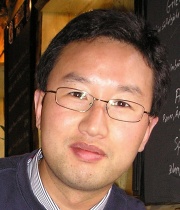Study Overview
Visual impairments (blindness and low vision) severely and negatively impact the quality of life. New sight-restoration treatments have arrived for some blinding diseases. In many cases, remarkable results have been demonstrated, suggesting that at least partial vision restoration is possible after prolonged blindness. However, psychophysical data from clinical trials often show large variance in outcomes. Preconditions in brain structure and function associated with the central visual pathway (CVP) may underlie some of the variance.
The effect of complete blindness upon the brain is well studied, but most ophthalmologic disease produces effects that vary from point-to-point across the retina. For example: How does the precise topography of eye disease map onto changes in brain? Is acquired retinal damage related to local effects upon the structure and function of the CVP? Are any of these effects of vision loss on the CVP reversible?
Project Timespan: Sept. 1, 2015 - Aug. 31, 2019
Investigators

Geoffrey Aguirre, M.D., Ph.D. - UPENN Principal Investigator
Dr. Aguirre is an Associate Professor of Neurology at the Perelman School of Medicine of University of Pennsylvania. He is a well-known vision scientist with extensive experience in the study of human cortical organization for vision, and how this organization is altered by neurologic and ophthalmologic disease. Dr. Aguirre will be responsible for the MRI and optical imaging data acquisition at University of Pennsylvania. He will also lead the fMRI and ophthalmic imaging data analysis for vision science research.
Contact: Email

Vivek Patel, MD, FRCSC - USC Principal Investigator
Dr. Patel is an Associate Professor of Ophthalmology and Director of Neuro-ophthalmology and Adult Strabismus at the USC Gayle and Edward Roski Eye Institute, Keck School of Medicine of USC. Dr. Patel’s expertise lies in the clinical investigation of patients with complex retinal and neurological visual disorders, and has made scientific contributions in these areas. Dr. Patel will lead the team from the Roski Eye Institute and Ophthalmology Department at USC for patient recruitment and acquisition of ophthalmic imaging data.
Contact: Email

Yonggang Shi, Ph.D. - USC Principal Investigator
Dr. Shi is a tenure-track Assistant Professor of Neurology and Electrical Engineering at Stevens Neuroimaging and Informatics Institute, Keck School of Medicine of USC. He has extensive research experience in connectome imaging and medical image analysis. In this project, Dr. Shi will be responsible for the MRI data acquisition at USC, informatics for both MRI and ophthalmic Imaging data collected in this project, and the analysis of MRI and ophthalmic imaging data.
Contact: Email
Study Protocol Overview
Data being collected
Data will be collected on a 3T Prisma-fit at the University of Southern California, and on a 3T Siemens Prism at the University of Pennsylvania.
- Standard HCP demographics
- Imaging: The HCP LifeSpan imaging protocol will be followed with one additional shell for diffusion MR. Task fMRI will be used, but because the study participants will be unable to use the HCP protocol’s visual stimuli, new tasks will be used, such as Visual Noise and Tactile tasks. Retinotopy will also be used for some participants. For resting-state fMRI, instead of requiring the participants to fixate, which most of our participants cannot do, they will be asked to keep their eyes open while wearing a light-excluding eye mask (made of black molded cell foam and nylon interlock fabric with a contoured rim) throughout the run.
- Clinical:
- Per eye: OD/OS, best corrected visual acuity, location(s) of preferred retinal locas (PRL), if any
- Retinal measurements: General condition, light sensitivity (visual field), vascular perfusion, sectorial RNFL thickness (MPB), topography of total retinal thickness, topography of GCL thickness
Cohort Description
Data will be collected on 260 participants between the ages 20 of and 80 years old. Up to 70 control participants will enrolled, 10 of which will be used for cross-site comparison between USC and UPENN.
Data Release Plans
- The first data release includes 90 participants.
- The second data release includes of 190 participants.
- The third data release includes of 260 participants.
Keywords
Age related macular degeneration; Blindness; Eye diseases; Visually Impaired Persons; retinal prosthesis;
Publications
Articles In Press:
Sun W, Amezcua L & Shi Y. FOD Restoration for Enhanced Mapping of White Matter Lesion Connectivity. Proc. MICCAI, 2017.
Wang J, Aydogan D, Varma R, Toga AW, Shi Y. Topographic Regularity for Tract Filtering in Brain Connectivity. Proc. IPMI, 2017.
Wang J & Shi Y. Kernel-Regularized ICA for Computing Functional Topography from Resting-state fMRI. Proc. MICCAI, 2017
Shi Y & Toga AW. Connectome Imaging for Mapping Human Brain Pathways. Molecular Psychiatry, 2017
Accepted Publications:
-
Probabilistic Tractography for Topographically Organized Connectomes.
Medical image computing and computer-assisted intervention : MICCAI ... International Conference on Medical Image Computing and Computer-Assisted Intervention, Jan 17, 2017 PMID: 28090602Show SummaryWhile tractography is widely used in brain imaging research, its quantitative validation is highly difficult. Many fiber systems, however, have well-known topographic organization which can even be quantitatively mapped such as the retinotopy of visual pathway. Motivated by this previously untapped anatomical knowledge, we develop a novel tractography method that preserves both topographic and geometric regularity of fiber systems. For topographic preservation, we propose a novel likelihood function that tests the match between parallel curves and fiber orientation distributions. For geometric regularity, we use Gaussian distributions of Frenet-Serret frames. Taken together, we develop a Bayesian framework for generating highly organized tracks that accurately follow neuroanatomy. Using multi-shell diffusion images of 56 subjects from Human Connectome Project, we compare our method with algorithms from MRtrix. By applying regression analysis between retinotopic eccentricity and tracks, we quantitatively demonstrate that our method achieves superior performance in preserving the retinotopic organization of optic radiation.
-
Automated retinofugal visual pathway reconstruction with multi-shell HARDI and FOD-based analysis.
Show SummaryDiffusion MRI tractography provides a non-invasive modality to examine the human retinofugal projection, which consists of the optic nerves, optic chiasm, optic tracts, the lateral geniculate nuclei (LGN) and the optic radiations. However, the pathway has several anatomic features that make it particularly challenging to study with tractography, including its location near blood vessels and bone-air interface at the base of the cerebrum, crossing fibers at the chiasm, somewhat-tortuous course around the temporal horn via Meyer's Loop, and multiple closely neighboring fiber bundles. To date, these unique complexities of the visual pathway have impeded the development of a robust and automated reconstruction method using tractography. To overcome these challenges, we develop a novel, fully automated system to reconstruct the retinofugal visual pathway from high-resolution diffusion imaging data. Using multi-shell, high angular resolution diffusion imaging (HARDI) data, we reconstruct precise fiber orientation distributions (FODs) with high order spherical harmonics (SPHARM) to resolve fiber crossings, which allows the tractography algorithm to successfully navigate the complicated anatomy surrounding the retinofugal pathway. We also develop automated algorithms for the identification of ROIs used for fiber bundle reconstruction. In particular, we develop a novel approach to extract the LGN region of interest (ROI) based on intrinsic shape analysis of a fiber bundle computed from a seed region at the optic chiasm to a target at the primary visual cortex. By combining automatically identified ROIs and FOD-based tractography, we obtain a fully automated system to compute the main components of the retinofugal pathway, including the optic tract and the optic radiation. We apply our method to the multi-shell HARDI data of 215 subjects from the Human Connectome Project (HCP). Through comparisons with post-mortem dissection measurements, we demonstrate the retinotopic organization of the optic radiation including a successful reconstruction of Meyer's loop. Then, using the reconstructed optic radiation bundle from the HCP cohort, we construct a probabilistic atlas and demonstrate its consistency with a post-mortem atlas. Finally, we generate a shape-based representation of the optic radiation for morphometry analysis.
-
Fiber Orientation and Compartment Parameter Estimation From Multi-Shell Diffusion Imaging.
Show SummaryDiffusion MRI offers the unique opportunity of assessing the structural connections of human brains in vivo. With the advance of diffusion MRI technology, multi-shell imaging methods are becoming increasingly practical for large scale studies and clinical application. In this work, we propose a novel method for the analysis of multi-shell diffusion imaging data by incorporating compartment models into a spherical deconvolution framework for fiber orientation distribution (FOD) reconstruction. For numerical implementation, we develop an adaptively constrained energy minimization approach to efficiently compute the solution. On simulated and real data from Human Connectome Project (HCP), we show that our method not only reconstructs sharp and clean FODs for the modeling of fiber crossings, but also generates reliable estimation of compartment parameters with great potential for clinical research of neurological diseases. In comparisons with publicly available DSI-Studio and BEDPOSTX of FSL, we demonstrate that our method reconstructs sharper FODs with more precise estimation of fiber directions. By applying probabilistic tractography to the FODs computed by our method, we show that more complete reconstruction of the corpus callosum bundle can be achieved. On a clinical, two-shell diffusion imaging data, we also demonstrate the feasibility of our method in analyzing white matter lesions.
-
Correction of distortion in flattened representations of the cortical surface allows prediction of V1-V3 functional organization from anatomy.
Show SummarySeveral domains of neuroscience offer map-like models that link location on the cortical surface to properties of sensory representation. Within cortical visual areas V1, V2, and V3, algebraic transformations can relate position in the visual field to the retinotopic representation on the flattened cortical sheet. A limit to the practical application of this structure-function model is that the cortex, while topologically a two-dimensional surface, is curved. Flattening of the curved surface to a plane unavoidably introduces local geometric distortions that are not accounted for in idealized models. Here, we show that this limitation is overcome by correcting the geometric distortion induced by cortical flattening. We use a mass-spring-damper simulation to create a registration between functional MRI retinotopic mapping data of visual areas V1, V2, and V3 and an algebraic model of retinotopy. This registration is then applied to the flattened cortical surface anatomy to create an anatomical template that is linked to the algebraic retinotopic model. This registered cortical template can be used to accurately predict the location and retinotopic organization of these early visual areas from cortical anatomy alone. Moreover, we show that prediction accuracy remains when extrapolating beyond the range of data used to inform the model, indicating that the registration reflects the retinotopic organization of visual cortex. We provide code for the mass-spring-damper technique, which has general utility for the registration of cortical structure and function beyond the visual cortex.
-
The retinotopic organization of striate cortex is well predicted by surface topology.
Show SummaryIn 1918, Gordon Holmes combined observations of visual-field scotomas across brain-lesioned soldiers to produce a schematic map of the projection of the visual field upon the striate cortex. One limit to the precision of his result, and the mapping of anatomy to retinotopy generally, is the substantial individual variation in the size, volumetric position, and cortical magnification of area V1. When viewed within the context of the curvature of the cortical surface, however, the boundaries of striate cortex fall at a consistent location across individuals. We asked whether the surface topology of the human brain can be used to accurately predict the internal, retinotopic function of striate cortex as well. We used fMRI to measure polar angle and eccentricity in 25 participants and combined their maps within a left-right, transform-symmetric representation of the cortical surface. These data were then fit using a deterministic, algebraic model of visual-field representation. We found that an anatomical image alone can be used to predict the retinotopic organization of striate cortex for an individual with accuracy equivalent to 10-25 min of functional mapping. This indicates tight developmental linkage of structure and function within a primary, sensory cortical area.